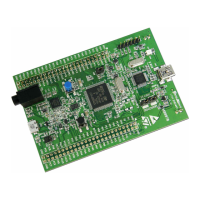PM0214 Rev 9 181/262
PM0214 The STM32 Cortex-M4 instruction set
261
3.11.1 BKPT
Breakpoint.
Syntax
BKPT #imm
Where:
• ‘imm’ is an expression evaluating to an integer in the range 0-255 (8-bit value).
Operation
The BKPT instruction causes the processor to enter Debug state. Debug tools can use this
to investigate system state when the instruction at a particular address is reached.
imm is ignored by the processor. If required, a debugger can use it to store additional
information about the breakpoint.
The BKPT instruction can be placed inside an IT block, but it executes unconditionally,
unaffected by the condition specified by the IT instruction.
Condition flags
This instruction does not change the flags.
Examples
BKPT 0xAB ; Breakpoint with immediate value set to 0xAB (debugger can
; extract the immediate value by locating it using the PC)

